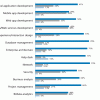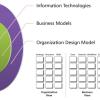Strategic advice to leverage new technologies
Technology is at the heart of nearly every enterprise, enabling new business models and strategies, and serving as the catalyst to industry convergence. Leveraging the right technology can improve business outcomes, providing intelligence and insights that help you make more informed and accurate decisions. From finding patterns in data through data science, to curating relevant insights with data analytics, to the predictive abilities and innumerable applications of AI, to solving challenging business problems with ML, NLP, and knowledge graphs, technology has brought decision-making to a more intelligent level. Keep pace with the technology trends, opportunities, applications, and real-world use cases that will move your organization closer to its transformation and business goals.
Recently Published
IT Trends in 2015 Survey Data
This survey explored interest in and adoption of various relatively new IT technologies and initiatives and investigated staffing and outsourcing trends in 80 organizations worldwide. Fifty percent of responding organizations are headquartered in North America, 19% in Asia/Australia/Pacific, 14% in Europe, and 11% in Africa, with the remainder in South America and the Middle East.
Hadoop can store and process huge amounts of social media and other unstructured data practically and cost effectively -- making it possible for organizations to perform analyses multiple times over in order to measure changing consumer or public opinion over time (e.g., comparing several months or years worth of findings).
How Many Darkitects Do You Have?
Shadow IT is symptomatic of how enterprises really operate. There are processes, systems, and structures that are visible on the surface, and these work well for the most part. However, there are activities, investments, people, and decisions that are outside of the well-delineated boundaries of an organizational function.
What Can EA Learn from Organization Design Models?
We can think of an "enterprise" as any human undertaking, endeavor, or project. Any enterprise comprises three areas: (1) an organization, (2) the businesses operated by the organization, and (3) any technologies or equipment needed to support the organization’s businesses. Enterprise architecture (EA) needs to support all three. It is striking that as EA has evolved over the last 40 years, there has been a parallel development: that of organization design (OD). In this Executive Report, we look at what EA can learn from OD models.
What Can EA Learn from Organization Design Models? (Executive Summary)
Data-Informed Decisions Are Best
There is a simple principle that would keep us from making grievous errors due to incomplete (or worse, inaccurate) data. Make "data-informed decisions" instead of the more common catchphrase of "data-driven decisions." The difference is an extremely important nuance.
Benefits of EA Metrics
The challenge in measuring EA value is not a lack of metrics; it is knowing which ones make sense for an organization and provide the most "value" for the effort. The key to a successful value measurement program is to identify metrics that correlate to business key performance indicators (KPIs).
Social business analytics enables organizations to apply real-time sentiment and insights derived from social media and enterprise sources to identify and target key influencers (on social media sites), generate new leads and opportunities, and improve customer loyalty.













